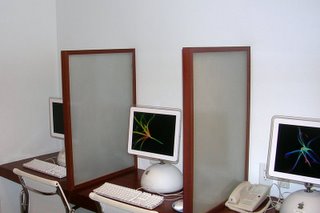
A Singapore Airlines 747-400 at Heathrow. On Singapore Airlines, the First Class passengers are in the front of the plane downstairs, and the top is used for Business Class.
Lufthansa puts its First Class cabins on the upper deck, and the front seats downstairs are for Business Class.

This is Lufthansa's First Class cabin on the Airbus 340, which I took from Munich to Washington. The strange looking metal boxes open up to accommodate the seat backs when they are converted into beds.
I recently had occasion to fly long haul in first class on two airlines that are considered among the world's best: Lufthansa and Singapore Airlines.
Both experiences were magnificent, and there was very little to complain about with either airline, but, to my surprise, the marginally better experience was Lufthansa. I will put details on the food and wine in a later posting, but, here is how I rate the experience in the following categories:
Food -- Lufthansa
The clear winner is Lufthansa. On Singapore Airlines, my main course was Lobster Thermidor; on Lufthansa I had goose. The goose was succulent, tasty, and something different. On the other hand, the sauce around the Lobster Thermidor on Singapore was a little bland, and there really was not much meat in the tail at all. A very disappointing offering!
Both airlines offered a great salad. But on Singapore, we were given a bottle of excellent virgin olive oil that I found much nicer than the prepared potato dressing on Lufthansa.
Both airlines offered caviar as one of the appetizers before the main course.
The dessert on Lufthansa was a Passion Fruit Consomme with Buttermilk Mousse. Wonderful!
Champagne -- Singapore
Nobody does better than Singapore Airlines. There is no better music than "Would you like the Krug or the Dom Perignon?" Lufthansa served a Cuvee Rare from Charles Heidsieck. Good, but I much preferred the Krug.
Wine -- Tie
This is difficult, and I think I would rate them equally. Singapore Airlines provided me with a 1998 Cos d’Estournel, which I enjoyed immensely. On the other hand, The William Wine (2000) from Graham Beck in South Africa was something different, and it was delicious although it is a much cheaper wine.
Lufthansa also offered an interesting dessert wine, Silvaner Eiswein, Weingut Guntrum, Nierstein 2004, which is described here. It is really nice to have a dessert wine that is an alternative to Port, the only dessert wine offering on Singapore Airlines. I award my "prize" to Lufthansa largely because I loved this wine so much.
Lounges -- Singapore
Singapore Airlines’ First Class passengers get to use Virgin’s Clubhouse at JFK, which is one of the best lounges I have ever been to. I have described the lounge and put up pictures here. I used Lufthansa’s lounges at Heathrow, Frankfurt, and Munich, and I really don’t like them very much. I understand that Lufthansa has upgraded the on-ground experience for its first class passengers at Frankfurt, and Munich will follow. This is a badly needed upgrade!
Singapore Airlines disappoints in one respect. After a transatlantic flight, it is nice to be able to have a shower and use a good lounge. British Airways has an arrival lounge at Heathrow that I think is a gold standard. Singapore seemed to offer nothing to arriving First Class passengers in Frankfurt. Finally, I was able to get into Lufthansa's Business Class lounge, but only because of my Premier Executive status with Star Alliance, but I had to wait almost an hour to get a shower.
Sleeper Suits -- Singapore
It is pretty much standard practice to give first class passengers sleeper suits on long haul flights. Singapore's came from Givenchy in a very useful bag. It was 100% cotton and very comfortable. For some reason, on Lufthansa gives you only a shirt. It was nice, but somehow incomplete.
Seats -- Lufthansa
The seats look wonderful on Singapore airlines, but I actually found the Lufthansa seat to be a bit more comfortable.
In-Flight Entertainment Systems -- Unknown!
There was so much to do on the plane! Eating, drinking, and sleeping took up most of the time. I also used the excellent Connexion system to check my e-mail. So I did not switch on the entertainment system on either flight. (Both airlines had in-seat power for my laptop.)
Both airlines have extremely attentive flight attendants, who seem to anticipate every need! I would love to fly Cathay Pacific in First Class! it is said to be wonderful, and I wonder whether that is the best First Class product that money can buy.


















 I used to live in Spain and often yearn for one of the delicious paellas that I used to enjoy there. Funnily enough, I recently found a perfect paella not in Spain, but in Cahuita, a beautiful little town on the Caribbean side of Costa Rica. The place is called
I used to live in Spain and often yearn for one of the delicious paellas that I used to enjoy there. Funnily enough, I recently found a perfect paella not in Spain, but in Cahuita, a beautiful little town on the Caribbean side of Costa Rica. The place is called 



